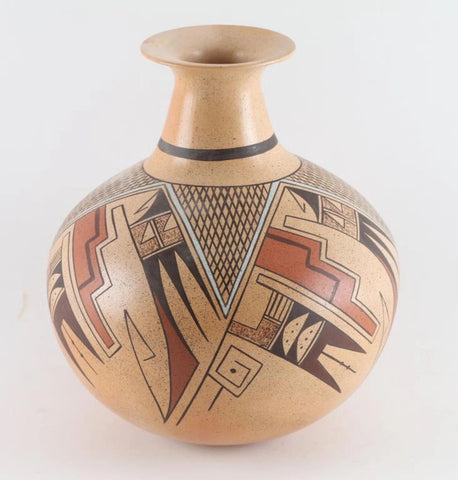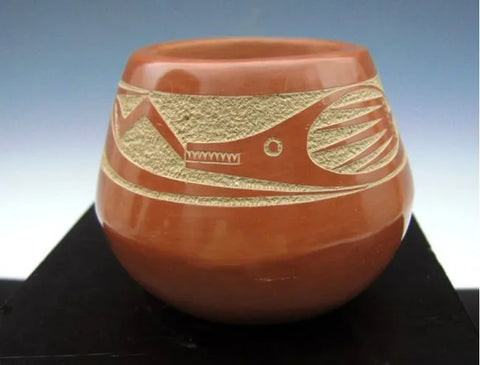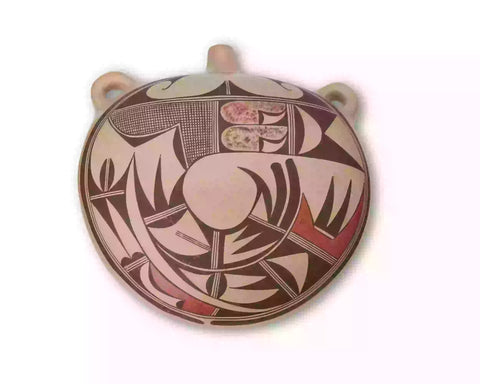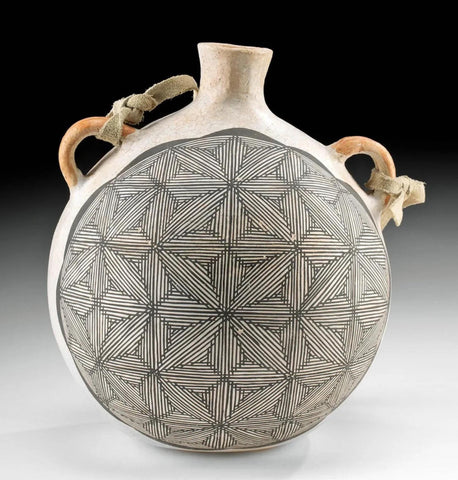
Pueblo Pottery Vase : Santa Domingo Pueblo Pottery Vase, by Robert Tenorio #6
$ 1,800.00
Native American
Santo Domingo Pueblo Pottery Vase
6. Native American, Santo Domingo Pueblo Pottery Vase. Signed on bottom: Robert Tenorio. Santo Domingo Pueblo, NM. 6" tall, 7.5" diameter. Wear on bottom, along with small stress crack that does not go all the way through. Other than this, very good condition for its age.
"Robert Tenorio was born in 1950 into the Santo Domingo Kewa Pueblo. He has been working with clay since the age of 10. He was taught all the fundamentals of hand coiling pottery using ancient traditional methods from his family members. Lupe Tenorio shared some of her special techniques with Robert. He was also inspired to continue the long lived family tradition from the admiration he had for old pottery from his village. Robert is truly one of the greatest Santo Domingo potters of any generation. Robert specializes in hand coiled, traditional Santo Domingo pottery. He gathers his clay and other natural pigments from within the Santo Domingo Pueblo. Then, he soaks the clay, cleans, sifts, mixes, hand coils, shapes, sands, paints, and fires his pottery outdoors, using cottonwood bark. The colors he uses to paint his pottery with are basically derived from native plants also hand picked by Robert, which are boiled together to make the paint to complete his masterpieces. He hand coils many shapes and sizes of pottery like water vessels, dough bowls, and traditional pots. Robert is continuously experimenting with different types of plants in hopes of making the special black color which was used as the pigment on pottery several hundred years ago. He signs his pottery as: Robert Tenorio followed by a small dipper star formation, and Kewa. He is related to: Paulita Pacheco (sister), Gilbert Pacheco (brother-in-law), Hilda Coriz (sister), Ione Coriz (niece), and Juanita Tenorio (mother).
Robert's pottery began winning awards in 1967. He received two First Place Awards at the 2004 Santa Fe Indian Market. He has received awards for pottery entered in the Heard Museum Show, Eight Northern Pueblos as well as other shows. In 2003, he placed first at the Eight Northern Pueblo Arts & Crafts Show. Awards keep coming his way."
Publications: Talking With The Clay by Stephen Trimble (2007); Southwestern Pottery, by Allan Hayes & John Blom; Hopi-Tewa Pottery: 500 Artist Biographies by Dr. Gregory Schaaf; Southern Pueblo Pottery: 2000 Artist Biographies, by Dr. Gregory Schaaf., and Two Raven's Pottery.
A History of Pueblo Pottery:
Pueblo pottery is made using a coiled technique that came into northern Arizona and New Mexico from the south, some 1500 years ago. In the four-corners region of the US, nineteen pueblos and villages have historically produced pottery. Although each of these pueblos use similar traditional methods of coiling, shaping, finishing and firing, the pottery from each is distinctive. Various clay's gathered from each pueblo's local sources produce pottery colors that range from buff to earthy yellows, oranges, and reds, as well as black. Fired pots are sometimes left plain and other times decorated most frequently with paint and occasionally with applique. Painted designs vary from pueblo to pueblo, yet share an ancient iconography based on abstract representations of clouds, rain, feathers, birds, plants, animals and other natural world features.
Tempering materials and paints, also from natural sources, contribute further to the distinctiveness of each pueblo's pottery. Some paints are derived from plants, others from minerals. Before firing, potters in some pueblos apply a light colored slip to their pottery, which creates a bright background for painted designs or simply a lighter color plain ware vessel. Designs are painted on before firing, traditionally with a brush fashioned from yucca fiber.
Different combinations of paint color, clay color, and slips are characteristic of different pueblos. Among them are black on cream, black on buff, black on red, dark brown and dark red on white (as found in Zuni pottery), matte red on red, and poly chrome a number of natural colors on one vessel (most typically associated with Hopi). Pueblo potters also produce un-decorated polished black ware, black on black ware, and carved red and carved black wares.
Making pueblo pottery is a time-consuming effort that includes gathering and preparing the clay, building and shaping the coiled pot, gathering plants to make the colored dyes, constructing yucca brushes, and, often, making a clay slip. While some Pueblo artists fire in kilns, most still fire in the traditional way in an outside fire pit, covering their vessels with large potsherds and dried sheep dung. Pottery is left to bake for many hours, producing a high-fired result.
Today, Pueblo potters continue to honor this centuries-old tradition of hand-coiled pottery production, yet value the need for contemporary artistic expression as well. They continue to improve their style, methods and designs, often combining traditional and contemporary techniques to create striking new works of art. (Source: Museum of Northern Arizona)
----------------
View the other items in my shop: http://www.etsy.com/shop/CulturalPatina?ref=shopsection_shophome_leftnav




